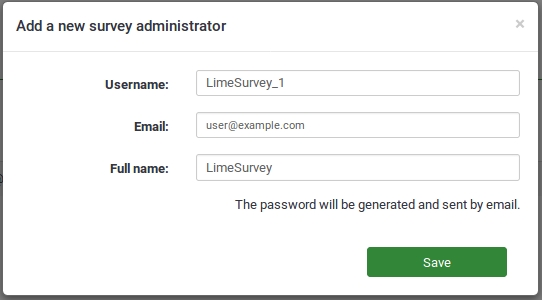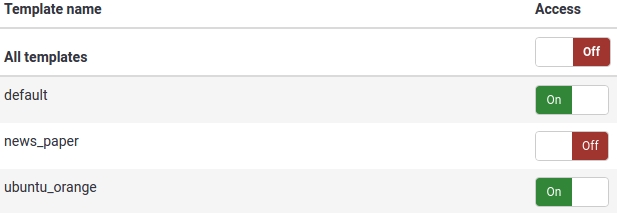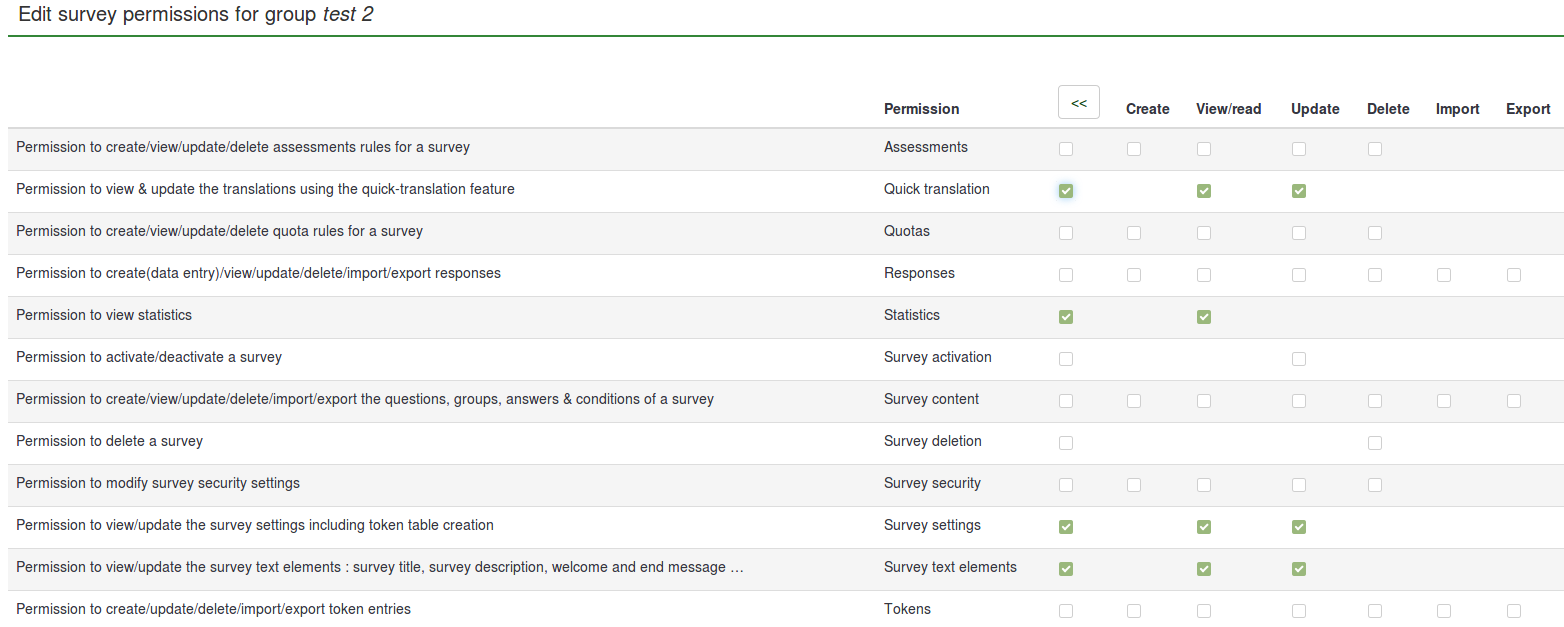Gestion des utilisateurs
From LimeSurvey Manual
Description
Si vous cliquez sur cet icône ![]() , vous accéderez à un outil de gestion des utilisateurs. Selon vos droits, vous pourrez modifier votre mot de passe, mais aussi créer de nouveaux utilisateurs ou modifier les utilisateurs existants. Ce sont des droits généraux, pour définir des droits à un utilisateur sur une enquêtes spécifique vous devez accéder a la gestion de sécurité du questionnaire
, vous accéderez à un outil de gestion des utilisateurs. Selon vos droits, vous pourrez modifier votre mot de passe, mais aussi créer de nouveaux utilisateurs ou modifier les utilisateurs existants. Ce sont des droits généraux, pour définir des droits à un utilisateur sur une enquêtes spécifique vous devez accéder a la gestion de sécurité du questionnaire
The user management tool allows you to add additional administration users to LimeSurvey. We will just call them 'users' in this chapter. Do not confuse them with survey participants (respondents).
Créer un utilisateur
Pour ajouter un nouvel utilisateur, remplissez les données sur le bas de la page
Then, click on Add user located in the upper right area of User control table. A window will show up asking you to:
- Nom d'utilisateur: Le nom qui sera utilisé pour se connecter
* Email: L'adresse de courriel de l'utilisateur utilisée pour envoyer le mot de passe et autres message administratif
* Nom complet: Nom tel qu'il apparaitrat aux autres utilisateurs
Quand vous cliquez sur ajouter un utilisateur, un mot de passe est automatiquement généré.
A moins que vous n'utilisiez le système de délégation au serveur web, un courriel est envoyé au nouvel utilisateur lui donnant toutes les informations pour se connecter. Si l'utilisateur n'a pas de mail valide, vous pouvez modifier manuellement le mot de passe à la suite.

You have now created your first user. To find out more about setting user permissions, please read on.

As you can see below, there are four options under the Action column that allow you to:

- edit the general aspects of a user - by clicking the pen symbol.
- delete the user from the survey administrators database - by clicking the wastebin button.
- set global permissions for a user - by clicking the lock symbol.
- set theme permissions for a user - by clicking the pen-and-lock symbol.
Droits et rôles des utilisateurs
Vous pourrez surtout définir, pour chacun, des rôles et des droits spécifiques. Ces droits déterminent si un utilisateur peut :
- Créer des questionnaires
- Configurer des questionnaires
- Créer d'autres utilisateurs
- Déplacer des utilisateurs
- Effacer des utilisateurs
- Gérer les modèles
- Gérer les jeux d'étiquettes et leurs étiquettes
You can set a new email address, full name, and even change his or her password. If you have finished what you want to do, click on the Save button (right upper part of the window).
Delete user
To delete a user account, simply click on his or her corresponding wastebin button (located on the same line as the user account you want to delete) and click OK.
Set global permissions for a user
To set global permissions for a user, click on the lock symbol.

The CRUD (create, read, update, and delete) system is employed (like in the survey permission settings). To fine-tune user permissions, we strongly recommend to extend the matrix using the double-right arrowhead, which is located in its upper right corner. If you check the first box, all the CRUD permissions in that row are automatically checked.

You can now add or remove the following permissions:
- Participant panel: For more details, continue reading about the central participant database here.
- Label sets: Permission to create, view, update, delete, export, and import label sets. The label sets don't have specific permissions (unlike themes).
- Settings & Plugins: With this permission a user can check data integrity, save the SQL database to an .sql file, manage global settings, view the PHP info in the global settings, and manage all plugins.
- Surveys: Gives access to all surveys. To allow a user to only create and manage their own survey, give the user the 'create' permission. A creator of a survey is the owner of the survey and will always be able to manage it. Remember that each survey can grant different permissions .
- Themes: It allows the user to use all the available design themes and edit all non-standard themes. A person with this right should have sufficient knowledge in terms of HTML, Javascript, and CSS. If a user is not familiar with these things and is supposed to use a specific design themes, it would be better to only give him 'read' permission. Each theme can have specific permissions.
- User groups: This permission allows a user to create/view/update/delete user groups.
- Users: A user can create, modify, and delete his own administration users with this permission. The newly created users cannot have higher permissions than the parent user. You will also not be able to edit users owned by other administration users. If this has to be done, then a Superadministrator permission has to be granted.
- Superadministrator: This permissions can only be added by other Superadministrator with this setting as update and grants full permission to the whole LimeSurvey application.
- Use internal database authentication: This permission allows users to access LimeSurvey's panel via the authentication page (e.g. http://domain/admin/authentication/sa/login). If it is unchecked and the respective user tries to connect to LimeSuvey's panel, he will get the following error: 'Internal database authentication method is not allowed for this user'.
Set theme permissions for a user
With theme permissions, you can decide which design themes a user can select when creating or editing a survey. It might be a good idea to restrict the design themes a user can select in order to prevent unwanted use of design themes, which you might consider to not be suitable for a survey/questionnaire.
For example, if you have a specific design themes for a group of users or customers, you might want to restrict their access to other themes to only make them use the themes created for their purpose.
To set or edit the themes permissions for a user, simply click the pen-and-lock symbol for design themes:

Select the design themes to which the respective user or user groups should have access. After you finished your selection or deselection, do not forget to hit the Save button: ![]() .
.
To get a proper understanding of this function, check the examples provided below.
Utilisation du mot de passe à utilisation unique (one time passwords)
A user can call the LimeSurvey login at /limesurvey/admin and enter a username and a one-time password (which was previously written into the users table - column one_time_pw - by an external application).
Depuis la version 1.81 un utilisateur peut se connecter à la console d'administration avec un nom d'utilisateur et un mot de passe à utilisation unique créé dans la table des utilisateur (colonne one_time_pw, soit lime_users.one_time_pw) par une autre application et codé en MD5.
Pour utiliser cette méthode, vous devez positionner $use_one_time_passwords à true dans config.php ($use_one_time_passwords = true;)
L'URL doit contenir les variables suivantes
- user: Le nom d'utilisateur utilisé pour se connecter à LimeSurvey. Ce nom d'utilisateur doit exister dans la table 'users'.
- onepass: Le mot de passe en clair correspondant au mot de passe de la tables 'users'.
Une URL valide serait par exemple
A vérifier
- Le mot de passe à utilisation unique doit être activé : $use_one_time_passwords = true; dans config.php
- Le nom d'utilisateur doit exister dans la base 'users' de limesurvey
- Le mot de passe à utilisation unique doit être codé en MD5 dans la colonne one_time_pwd de la table 'users'.
- Le mot de passe en clair va être codé par la fonction md5() de php et être comparé à la valeur de one_time_pwd correspondant à l'utilisateur de la table 'users'.Les 2 doivent correspondre.
- Si vous êtes confrontés à des coupure de session (timeout), vous pouvez augmenter la durée des sessions avec le paramètre $sessionlifetime (Par défaut 3600 secondes)
Set permissions for a single survey
These permissions only apply for a single survey. If you want to set permissions for the whole system, you can use global permissions. These permissions can be offered either to a single user or to a user group.
To change the survey permissions, you have to select the Settings sidebar of your survey. Then, click on Survey permissions and choose to whom would you like to offer permissions. The rights can be offered either separately to specific users or to a user group.


Grant survey permissions to a user
In the next step, select the user that will receive survey rights and click Add user.

After you click Set survey permissions, the user's survey permissions matrix will be shown.

You can set in this matrix the user's survey permissions. Checking a box grants survey permissions to the respective user. If you click on a checkbox from the first column, all the rights of the corresponding line will be selected/removed.
Click on the double-right arrowhead to access the extended version of the matrix to choose specifically the actions that can be performed by a user. After you finished editing the survey permissions, click on the Save button, which is located in the upper right corner of the screen.
Some examples are provided below in order to help you get a better understanding of Limesurvey's survey permissions system.
Grant survey permissions to a user group
Click on add a user group and select the user group to which you would like to add the permission rights.

In the next step, select the permissions that you will allocate to the members of that user group. Do not forget to click on the double right arrowhead to get an extended view of the permissions matrix.

After you finished editing the survey permissions, click on the Save button, which is located in the upper right part of the screen.
Some examples are provided below in order to help you get a better understanding of the Limesurvey's survey permissions system.
Examples
Different scenarios are presented below. They provide some advice about which rights are necessary for some specific tasks and how they can be granted to the users.
I want to add a new person in charge for administrating LimeSurvey
- Log in as admin.
- Create a new user account.
- Grant that user the Superadministrator permission.
- Not necessary : Setting the theme permissions (Superadministrator has all permissions for all themes).
- Not necessary : Setting the survey permissions (Superadministrator has all permissions for all surveys).
A new user wants to create his/her own surveys
- Log in as admin (or as a user that has the Superadministrator permission).
- Create a new user account.
- Set global permissions for that user to Create survey.
- Optional : Set theme permissions - select which theme(s) should be used by the user/user group.
The creator of a survey needs another person to edit his/her survey
- Log in as admin (or as a user that has the Superadministrator permission).
- Create a new user account.
- Set no global permissions for user.
- Set no theme permissions for user.
- Set the survey permissions the way you want. If he/she should receive all the survey permissions, you can check the first box from each row. Otherwise, click on the double-right arrowhead to see the expanded matrix (upper right corner) and select only those rights you believe the respective user should have.
A person responsible for the survey wants to see the results of the survey and export them
- Log in as admin (or as a user that has the Superadministrator permission).
- Create a new user account.
- Set no global permissions for user.
- Set no theme permissions for user.
- Set survey permissions to: Responses -> View/read and export, and Statistics: View/read.

I need help from two interns that can help me with the translation of my survey
- Log in as admin (or as a user that has the Superadministrator permission).
- Create n user accounts (where n is the number of translators).
- Create a user group called Translators and add the n accounts to this group.
- Go to the Survey permissions and click on Add a user group.
- If they only do translations, then offer them the Quick translation permission.